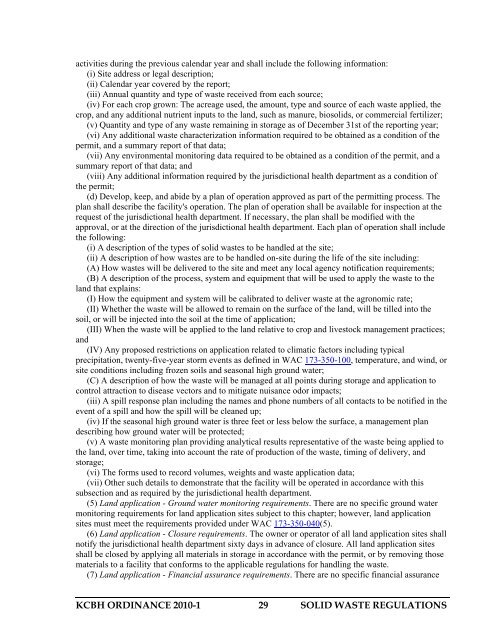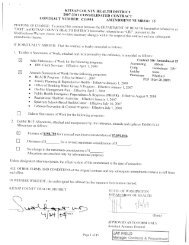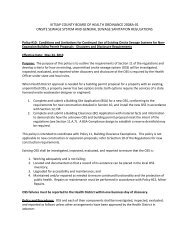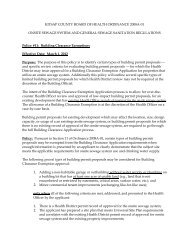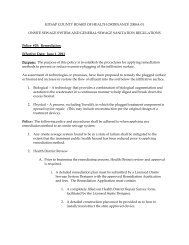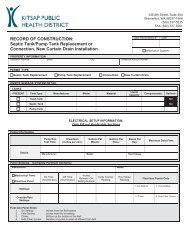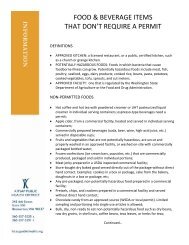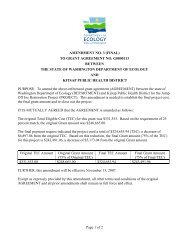SOLID WASTE REGULATIONS - Kitsap Public Health District
SOLID WASTE REGULATIONS - Kitsap Public Health District
SOLID WASTE REGULATIONS - Kitsap Public Health District
You also want an ePaper? Increase the reach of your titles
YUMPU automatically turns print PDFs into web optimized ePapers that Google loves.
activities during the previous calendar year and shall include the following information:<br />
(i) Site address or legal description;<br />
(ii) Calendar year covered by the report;<br />
(iii) Annual quantity and type of waste received from each source;<br />
(iv) For each crop grown: The acreage used, the amount, type and source of each waste applied, the<br />
crop, and any additional nutrient inputs to the land, such as manure, biosolids, or commercial fertilizer;<br />
(v) Quantity and type of any waste remaining in storage as of December 31st of the reporting year;<br />
(vi) Any additional waste characterization information required to be obtained as a condition of the<br />
permit, and a summary report of that data;<br />
(vii) Any environmental monitoring data required to be obtained as a condition of the permit, and a<br />
summary report of that data; and<br />
(viii) Any additional information required by the jurisdictional health department as a condition of<br />
the permit;<br />
(d) Develop, keep, and abide by a plan of operation approved as part of the permitting process. The<br />
plan shall describe the facility's operation. The plan of operation shall be available for inspection at the<br />
request of the jurisdictional health department. If necessary, the plan shall be modified with the<br />
approval, or at the direction of the jurisdictional health department. Each plan of operation shall include<br />
the following:<br />
(i) A description of the types of solid wastes to be handled at the site;<br />
(ii) A description of how wastes are to be handled on-site during the life of the site including:<br />
(A) How wastes will be delivered to the site and meet any local agency notification requirements;<br />
(B) A description of the process, system and equipment that will be used to apply the waste to the<br />
land that explains:<br />
(I) How the equipment and system will be calibrated to deliver waste at the agronomic rate;<br />
(II) Whether the waste will be allowed to remain on the surface of the land, will be tilled into the<br />
soil, or will be injected into the soil at the time of application;<br />
(III) When the waste will be applied to the land relative to crop and livestock management practices;<br />
and<br />
(IV) Any proposed restrictions on application related to climatic factors including typical<br />
precipitation, twenty-five-year storm events as defined in WAC 173-350-100, temperature, and wind, or<br />
site conditions including frozen soils and seasonal high ground water;<br />
(C) A description of how the waste will be managed at all points during storage and application to<br />
control attraction to disease vectors and to mitigate nuisance odor impacts;<br />
(iii) A spill response plan including the names and phone numbers of all contacts to be notified in the<br />
event of a spill and how the spill will be cleaned up;<br />
(iv) If the seasonal high ground water is three feet or less below the surface, a management plan<br />
describing how ground water will be protected;<br />
(v) A waste monitoring plan providing analytical results representative of the waste being applied to<br />
the land, over time, taking into account the rate of production of the waste, timing of delivery, and<br />
storage;<br />
(vi) The forms used to record volumes, weights and waste application data;<br />
(vii) Other such details to demonstrate that the facility will be operated in accordance with this<br />
subsection and as required by the jurisdictional health department.<br />
(5) Land application - Ground water monitoring requirements. There are no specific ground water<br />
monitoring requirements for land application sites subject to this chapter; however, land application<br />
sites must meet the requirements provided under WAC 173-350-040(5).<br />
(6) Land application - Closure requirements. The owner or operator of all land application sites shall<br />
notify the jurisdictional health department sixty days in advance of closure. All land application sites<br />
shall be closed by applying all materials in storage in accordance with the permit, or by removing those<br />
materials to a facility that conforms to the applicable regulations for handling the waste.<br />
(7) Land application - Financial assurance requirements. There are no specific financial assurance<br />
KCBH ORDINANCE 2010-1 29 <strong>SOLID</strong> <strong>WASTE</strong> <strong>REGULATIONS</strong>


